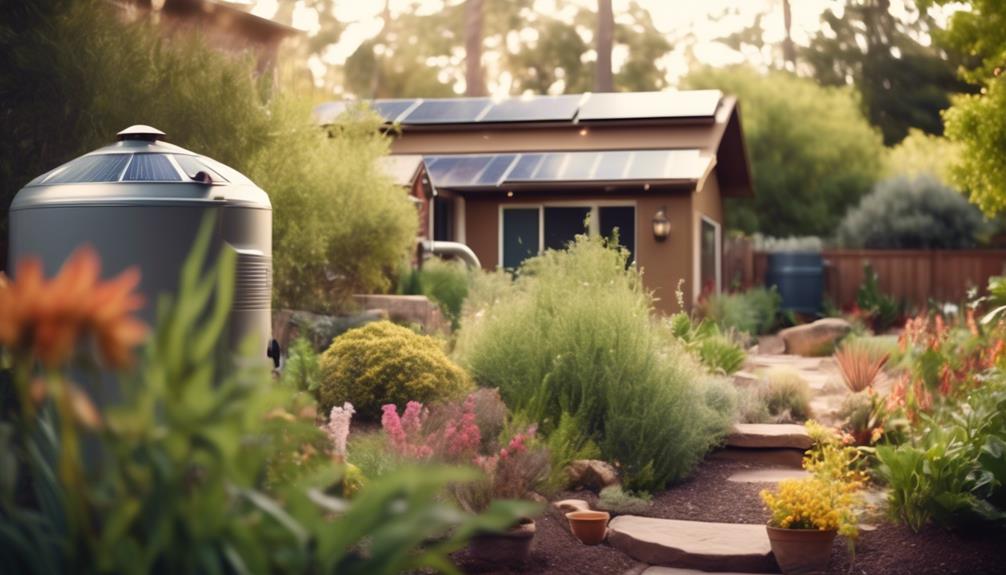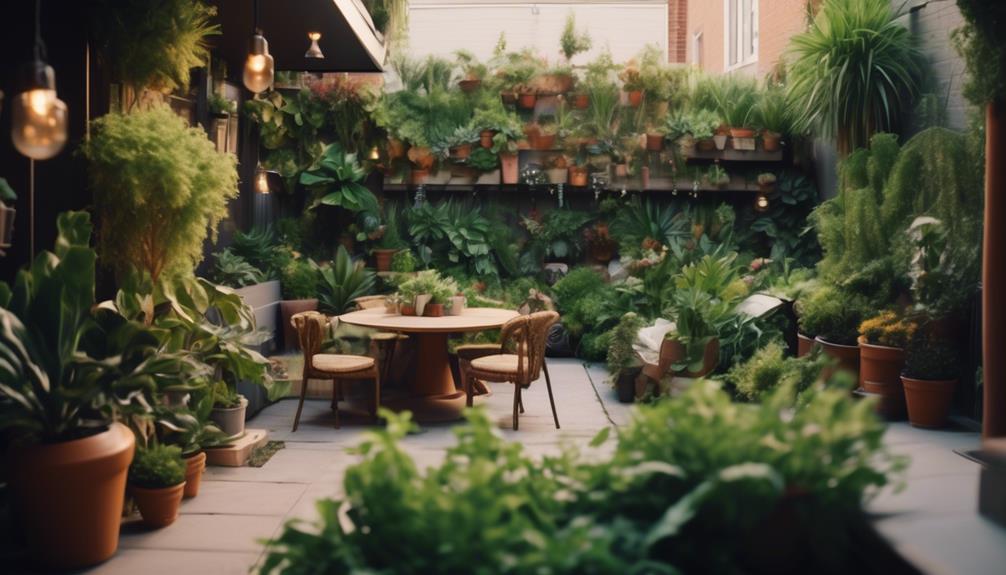I’ve recently discovered that traditional English garden landscaping is not only timeless but also incredibly popular, with over 75% of garden enthusiasts considering it as their top choice for landscaping styles.
As someone who appreciates the elegance and charm of a traditional English garden, I’ve spent years honing my skills and mastering the art of creating these picturesque landscapes. Through trial and error, I’ve compiled a list of 13 essential tips that have consistently brought success to my projects.
These tips encompass everything from selecting the right plants to incorporating classic garden structures, and I’m eager to share them with you.
So, let’s get started on transforming your outdoor space into a stunning traditional English garden.
Key Takeaways
- Consider incorporating stone walls, wrought-iron gates, wooden arbors, and hedges to create boundaries, grand entrances, and picturesque passageways in a traditional English garden.
- Focus on creating symmetrical layouts and incorporating focal points for an elegant and ordered look.
- Use hedges to define spaces, provide privacy and shelter, and add structure to the garden.
- Pay attention to the placement and scale of focal points for maximum impact and ensure they harmonize with the surrounding greenery and hardscaping.
Choosing the Right Plants
When selecting plants for an English garden, consider the soil type, sunlight exposure, and climate of your specific location to ensure successful growth and a harmonious landscape.
For plant selection, it’s crucial to choose species that thrive in your soil type. For example, if you have clay soil, opt for plants like lavender, heather, or potentilla. These plants are well-suited to the alkaline nature of clay soil.
Sunlight exposure is another vital factor. If your garden gets limited sunlight, go for shade-loving plants such as hostas, ferns, or foxgloves. On the other hand, for sunny spots, consider plants like lavender, roses, or peonies.
Additionally, pay attention to the climate of your location. Select plants that can withstand the typical weather conditions in your area to minimize maintenance efforts and ensure year-round beauty. Incorporating a mix of evergreen and flowering plants can help maintain the garden’s appeal throughout the seasons while reducing the need for frequent replanting.
- What Are Easy Low-Maintenance Yard Design Ideas?
- 13 Tips for Traditional English Garden Landscaping
- Affordable DIY Landscaping Tips for Small Yards
- Beginner’s Seasonal Yard Maintenance Guide for London Homeowners
- What Are the Best Child-Friendly Yard Designs?
Incorporating Hedges and Topiaries
When incorporating hedges into an English garden, it’s important to consider their placement to create natural, flowing lines and provide privacy or structure.
Proper topiary care involves regular pruning to maintain the desired shape and size, as well as ensuring that the plants receive adequate sunlight and water.
These elements can add a touch of elegance and formality to the garden while also serving practical and aesthetic purposes.
Hedge Placement
To create an elegant and cohesive garden design, consider incorporating hedges and topiaries strategically throughout the landscape. Proper spacing of hedges is crucial for a well-maintained appearance. When planting hedges, ensure they are spaced according to their mature width to avoid overcrowding. Regular hedge trimming techniques such as shearing, hand-pruning, and topiary sculpting help maintain the desired shape and density. Here’s a helpful guide for proper hedge placement:
| Aspect | Consideration |
|---|---|
| Sun Exposure | Ensure hedges receive adequate sunlight for healthy growth. |
| Focal Points | Use hedges to frame and accentuate key garden features. |
| Privacy | Strategically place hedges to create secluded areas within the garden. |
Strategically placed hedges not only add structure and privacy but also enhance the overall aesthetic of the garden.
Topiary Care
Incorporating hedges and topiaries into the garden landscape requires regular maintenance and proper care to ensure they maintain their desired shape and enhance the overall aesthetic.
When it comes to topiary care, pruning is essential for maintaining the shape and promoting healthy growth. Use sharp shears to carefully trim new growth, always following the natural form of the plant. Consider the specific shaping techniques for different topiary styles, such as spirals, cones, or animal shapes, and prune accordingly.
It’s important to monitor the growth regularly, especially during the growing season, to prevent the topiary from losing its defined shape. By employing proper pruning tips and shaping techniques, you can ensure that your topiaries remain a striking feature in your traditional English garden landscape.
Creating Winding Pathways
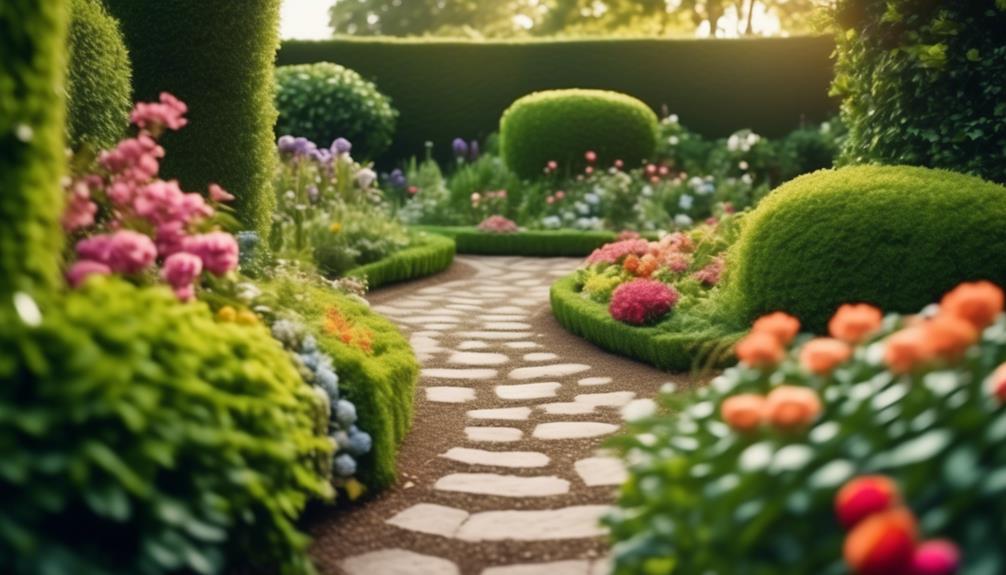
As I carefully plan the layout of my English garden, I weave winding pathways throughout the landscape to create a sense of exploration and discovery for visitors. When selecting pathway materials, opt for natural options like gravel, flagstone, or brick pavers, which complement the traditional English garden aesthetic. These materials blend harmoniously with the surrounding greenery and evoke a timeless charm.
In terms of design, I prefer curved pathways that meander gently, allowing for a leisurely stroll through the garden. This design choice enhances the feeling of wandering and adds a touch of romance to the overall ambiance.
For lighting, consider discreet options such as low-voltage LED pathway lights. These provide a subtle glow that illuminates the way without overpowering the natural beauty of the garden at night.
When it comes to edging, I find that using low hedge plants or a combination of low walls and flowering borders creates a soft and inviting boundary for the pathways. The edging seamlessly integrates the pathways into the garden, offering a clear delineation while maintaining a cohesive and natural look.
Adding a Focal Point
Weaving winding pathways through the landscape has set the stage for adding a focal point that will draw visitors’ attention and enhance the overall charm of my English garden. When considering focal point placement, it’s important to choose a location that naturally attracts the eye.
This could be the end of a pathway, a central spot visible from multiple angles, or a strategic point near seating areas. The focal point should be designed to complement the garden’s style and theme. For example, a classic English garden might feature a stone fountain, a charming gazebo, or a sculptural topiary as a focal point.
The design should harmonize with the surrounding greenery and hardscaping, offering a sense of balance and unity. Additionally, the scale of the focal point is crucial. It should be large enough to be noticed and make an impact, but not so overpowering that it detracts from the natural beauty of the garden.
Using Traditional English Garden Structures
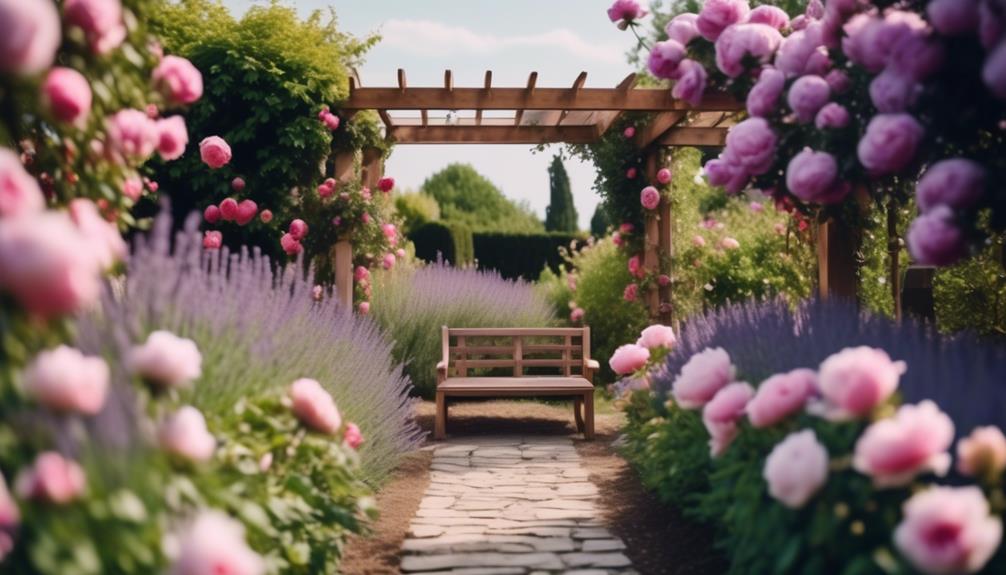
To create an authentic English garden, I recommend incorporating traditional garden structures such as stone walls, wrought-iron gates, and wooden arbors to add a timeless charm and structure to the landscape. These classic garden ornaments not only define the space but also add a sense of history and elegance to the garden. Here’s a practical breakdown of how these traditional structures can be used in an English garden:
| Traditional Garden Structure | Purpose |
|---|---|
| Stone Walls | Provide boundaries and create distinct garden sections. |
| Wrought-Iron Gates | Add a touch of grandeur and serve as entrances to different garden areas. |
| Wooden Arbors | Offer a framework for climbing plants and create picturesque passageways. |
Incorporating these traditional garden structures will bring an intimate and timeless appeal to your landscape, evoking the classic English garden charm. When choosing or designing these elements, consider their placement and how they can complement the overall layout and design of your garden. By carefully integrating these structures, you can achieve a traditional English garden that exudes warmth and sophistication.
Implementing Formal Garden Design
When implementing formal garden design, it’s important to focus on creating symmetrical layouts that exude elegance and order.
Proper use of hedges can help define spaces and add a sense of structure to the garden, while also providing privacy and shelter.
Additionally, incorporating focal points such as statues, topiaries, or water features can enhance the aesthetic appeal and draw attention to specific areas within the landscape.
Symmetry in Garden Design
Implementing formal garden design with symmetry creates an elegant and balanced aesthetic that is pleasing to the eye. When it comes to plant placement, symmetry plays a vital role in achieving a harmonious look. To create balance in your garden, consider the placement of plants in a way that mirrors each other across a central axis. This can be achieved by using identical plant varieties or by strategically placing different plants with similar visual weight on either side. To illustrate this further, consider the following table:
| Left Side | Right Side |
|---|---|
| Rose Bush | Rose Bush |
| Boxwood Hedge | Boxwood Hedge |
| Lavender Border | Lavender Border |
| Small Fountain | Small Fountain |
| Pathway with Pavers | Pathway with Pavers |
Implementing symmetry in garden design not only creates a sense of order but also adds a touch of formality and elegance to the overall landscape.
Proper Use of Hedges
Using hedges in formal garden design can add structure, privacy, and a sense of formality to the landscape. When it comes to hedge trimming, it’s essential to maintain a neat and uniform appearance. Regular pruning keeps hedges dense and compact, contributing to the overall formal aesthetic of the garden.
Additionally, hedges play a crucial role in creating privacy. They can act as natural barriers, enclosing specific areas of the garden and providing seclusion. To ensure privacy, it’s important to choose dense, evergreen hedge varieties and maintain them at the desired height.
Properly placed hedges also define pathways and borders, enhancing the traditional and symmetrical look of a formal English garden. In essence, hedges aren’t only functional but also contribute significantly to the overall beauty and structure of a traditional English garden.
Focal Points in Landscaping
To create a formal garden design with strong focal points, incorporating well-maintained hedges as structural elements is essential for defining the overall aesthetic and providing privacy.
However, to truly elevate the visual appeal, integrating a striking focal point such as a garden sculpture can bring a sense of grandeur and elegance to the landscape. When selecting a garden sculpture, consider its size, material, and style to ensure it complements the surrounding greenery and architectural features.
Placing the sculpture strategically within the garden, such as at the intersection of pathways or as a centerpiece in a symmetrical layout, draws the eye and creates a sense of balance and harmony.
A well-chosen garden sculpture not only serves as a focal point but also adds a touch of sophistication to the formal garden design.
Selecting Classic Garden Ornaments
When selecting classic garden ornaments, consider the timeless appeal and the visual impact they will have on the overall garden design. Ornamental statues and bird baths can add a touch of elegance and whimsy to the garden, while classic garden urns and sundials bring a sense of tradition and history. To help you visualize the impact of these ornaments, here’s a simple table:
| Classic Garden Ornaments | Visual Impact |
|---|---|
| Ornamental statues | Elegance and charm |
| Bird baths | Whimsical and inviting |
| Classic garden urns | Timeless and traditional |
| Sundials | Historical and functional |
These classic garden ornaments can serve as focal points or accents in your landscape, creating a sense of intimacy and charm. When choosing these ornaments, consider the scale of your garden and the overall theme you want to achieve. A carefully placed ornamental statue can draw the eye and create a sense of wonder, while a well-positioned sundial can add both beauty and functionality to your outdoor space. Selecting the right classic garden ornaments can truly elevate the ambiance of your traditional English garden.
Incorporating Water Features

When incorporating water features into an English garden, it’s important to consider fountain placement options to create a harmonious and visually appealing landscape.
Choosing the right size for the water feature is crucial, as it should complement the overall garden design without overwhelming the space.
Additionally, understanding the maintenance and care required for the water feature is essential for keeping it in good condition and preserving the garden’s aesthetic.
Fountain Placement Options
Consider incorporating a fountain into your English garden landscape to create a focal point and introduce the soothing sound of running water. When considering fountain placement options, it’s important to choose a location that complements the overall design while ensuring easy access for maintenance.
Water feature designs can vary from classical tiered fountains to modern minimalist styles, so it’s essential to select one that harmonizes with the garden’s aesthetic. Placing a fountain near a seating area can enhance the relaxing atmosphere and provide a calming backdrop for outdoor activities. Additionally, consider integrating the fountain into existing pathways or near the entrance to welcome guests with its tranquil ambiance.
Proper fountain maintenance is crucial for longevity, so ensure easy access for cleaning and occasional repairs when deciding on the best placement option.
Choosing the Right Size
To ensure the harmonious integration of water features into an English garden landscape, it’s essential to carefully consider the right size for incorporating fountains or other water elements. When choosing the right planters for your water features, consider the overall scale and style of your garden.
For smaller gardens, opt for smaller fountains or water features to avoid overwhelming the space. Proper spacing is crucial to create a balanced and natural look. Ensure that the water features aren’t crowded, allowing them to become focal points without overshadowing the surrounding plants.
Additionally, consider the visual impact from different vantage points within the garden to ensure that the size and placement of the water features complement the overall aesthetic. Choose the right size and spacing to create a tranquil and inviting atmosphere in your English garden.
Maintenance and Care
After incorporating water features into your English garden landscape, regular maintenance and care are essential to preserve their beauty and functionality. Pruning techniques play a crucial role in keeping your garden’s water features looking tidy and healthy. Regularly trim back overgrown plants and remove any dead or decaying foliage to maintain a neat and polished appearance.
When it comes to seasonal care, it’s important to adjust your maintenance routine according to the changing seasons. In the spring, focus on soil preparation and fertilization strategies to promote healthy growth and vibrant blooms.
During the summer months, keep a close eye on water levels and ensure proper circulation in your water features.
In the fall, prepare your garden for the winter months by clearing away debris and protecting delicate plants from the cold.
Maintaining Balance and Symmetry
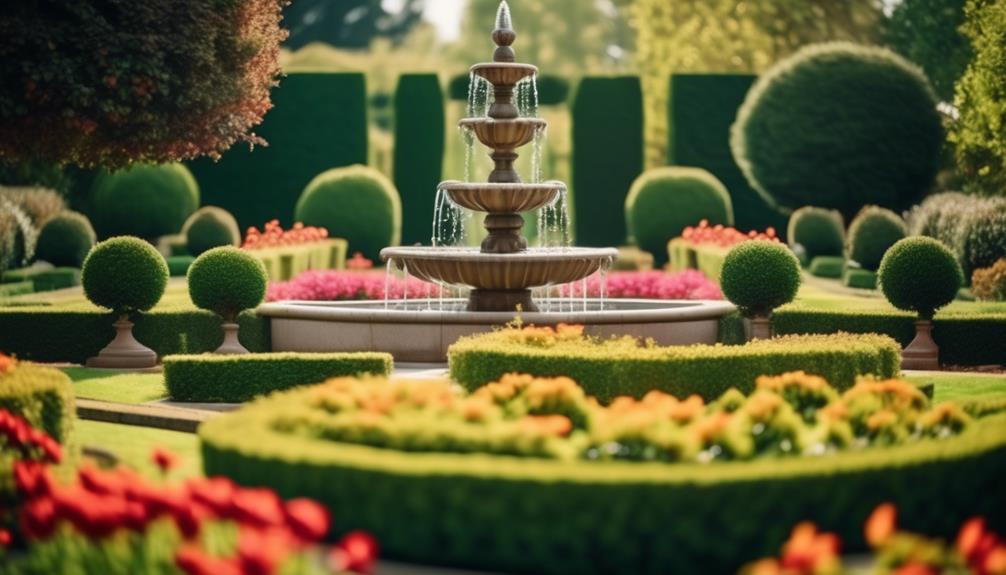
Achieving balance and symmetry in your English garden landscape requires careful planning and thoughtful placement of elements. To enhance visual appeal, I recommend starting with a focal point, such as a sculpture, fountain, or a beautifully manicured tree. This will serve as the centerpiece and anchor for the rest of your garden.
When it comes to plant arrangement, consider using pairs of identical or similar plants on either side of the focal point, creating a sense of equilibrium. For example, if you place a large hydrangea bush on one side, balance it with another on the opposite side. Additionally, pay attention to the height and color of the plants to maintain a harmonious look.
Regular pruning and trimming are essential to preserve symmetry, so make sure to invest time in maintenance. Lastly, consider incorporating pathways or hedges to create structure and delineate different areas within the garden.
Utilizing Cottage Garden Elements
Maintaining balance and symmetry in the English garden landscape sets the stage for incorporating cottage garden elements that bring a charming and quaint appeal to the overall design. When integrating cottage garden elements into a traditional English garden, it’s essential to focus on creating a relaxed and informal atmosphere.
One of the key features of a cottage garden is the abundant mix of flowers, herbs, and vegetables, so consider planting a variety of these in a seemingly haphazard yet artful manner. Traditional designs often include picket fences or low hedges to define the garden’s borders, providing a sense of enclosure while maintaining an open, welcoming feel.
Additionally, adding winding pathways made of natural materials like gravel or stepping stones can enhance the romantic, nostalgic ambiance that’s characteristic of cottage gardens. To further capture the essence of a cottage garden, consider incorporating vintage garden furniture, such as wrought iron benches or weathered wooden tables, where one can sit and enjoy the peaceful surroundings.
Creating a Cutting Garden
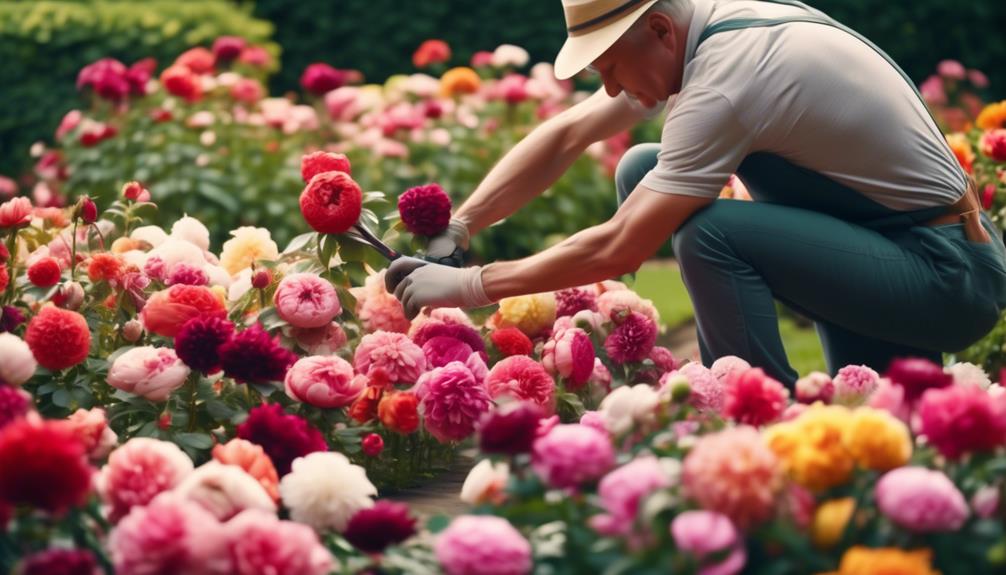
To create a cutting garden, begin by selecting a variety of flowers and foliage that are well-suited for harvesting and arranging in bouquets. Consider including classic blooms like roses, dahlias, and peonies, along with fillers such as baby’s breath and greenery like eucalyptus and ferns. It’s essential to choose plants that will thrive in your specific climate and soil conditions, ensuring a sustainable garden that requires minimal intervention.
When planning your cutting garden, think about the timing of blooms to ensure a constant supply of fresh flowers for arrangements throughout the growing season. Incorporating a mix of early, mid, and late-season flowering plants will allow you to enjoy a continuous harvest for your flower arrangements. Additionally, consider adding perennial plants alongside annuals to provide long-term sustainability for your cutting garden.
To maintain a sustainable cutting garden, practice responsible harvesting techniques by only taking a portion of the stems, allowing the plant to continue producing. Furthermore, implementing organic gardening practices, such as composting and natural pest control, will contribute to the overall health and sustainability of your cutting garden. By embracing sustainable gardening methods, you can enjoy a bountiful supply of beautiful blooms for your flower arrangements while maintaining an eco-friendly garden.
Embracing Naturalistic Planting
As I explore further into the realm of English garden landscaping, the concept of embracing naturalistic planting becomes a pivotal element in creating a harmonious and sustainable outdoor space. Naturalistic planting involves creating a landscape that mimics the patterns and interrelationships found in nature.
By incorporating native plants, grasses, and wildflowers, a garden can seamlessly blend into its surroundings, providing a haven for local wildlife. This approach not only enhances the beauty of the garden but also plays a vital role in wildlife habitat creation.
When embracing naturalistic planting, it’s essential to consider the specific needs of local fauna. Selecting a diverse range of plants that provide food, shelter, and nesting sites can attract a variety of birds, butterflies, bees, and other beneficial insects. Additionally, incorporating water features like ponds or small streams can further enhance the habitat and attract amphibians, dragonflies, and other aquatic wildlife.
In essence, embracing naturalistic planting is more than just creating a visually appealing garden; it’s about fostering a thriving ecosystem that supports local wildlife. By carefully selecting and arranging plants to mimic natural landscapes, we can create a sustainable and biodiverse environment that enriches our outdoor spaces.
Adding Fragrant Blooms
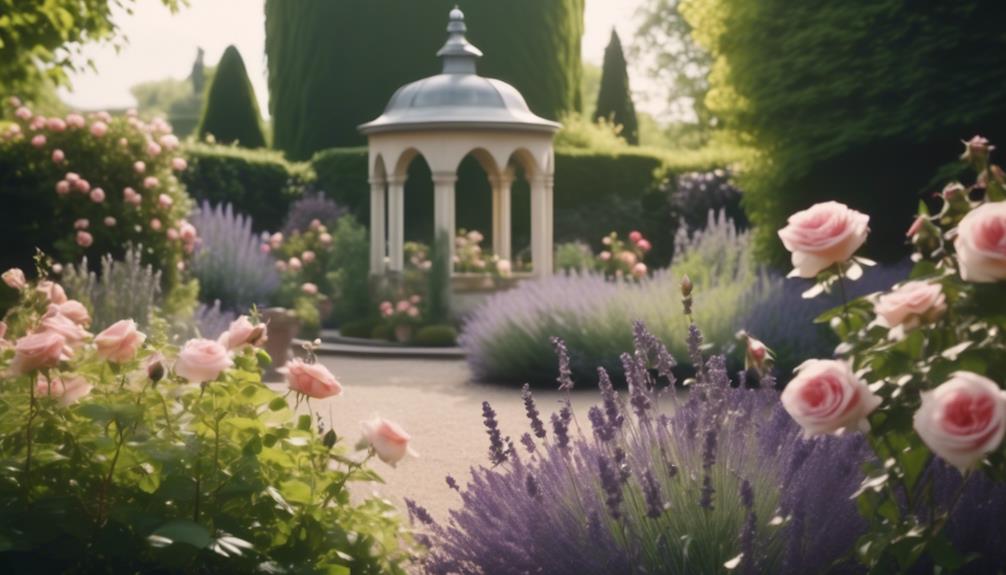
I’ll share some tips for incorporating fragrant blooms into your English garden landscaping.
When choosing fragrant flowers for your garden, consider including varieties like roses, lavender, jasmine, and lilac. These blossoms not only add a delightful aroma to your garden but also contribute to its visual appeal.
To maximize the impact of garden scents, strategically place fragrant flowers along pathways, near seating areas, or close to windows and doorways. This way, you can fully enjoy their beautiful aroma as you move around your garden or relax outdoors.
Additionally, consider planting a mix of early, mid, and late blooming fragrant flowers to ensure a continuous infusion of scents throughout the growing season.
Don’t forget to incorporate foliage with aromatic properties, such as scented geraniums or mint, to enhance the overall sensory experience in your garden.
Lastly, regular deadheading and proper maintenance won’t only promote continuous blooming but also help intensify the fragrance of these beautiful additions to your English garden.
Frequently Asked Questions
How Can I Incorporate Traditional English Garden Elements Into a Modern Landscape Design?
I’m blending old and new to achieve timeless elegance by incorporating modern elements while preserving authenticity. It’s about striking the perfect balance between traditional English garden elements and contemporary landscape design.
Are There Any Specific Plants or Flowers That Are Considered Essential for a Traditional English Garden?
Essential plants and flowers for a traditional English garden include roses, lavender, peonies, and foxgloves. Modernizing traditional elements involves adapting the style to climate restrictions, such as using drought-resistant varieties.
What Are Some Tips for Maintaining a Traditional English Garden in a Climate That Is Not Typically Suited for This Style of Landscaping?
Maintaining a traditional English garden in an unsuitable climate involves adapting modern techniques. I focus on selecting hardy plant varieties, providing proper shelter, and adjusting watering and soil conditions to create an authentic garden experience.
How Can I Create a Sense of History and Nostalgia in My Traditional English Garden Design?
To create ambiance and historical charm in my traditional English garden, I focus on nostalgic features and timeless appeal. Utilizing vintage elements, heirloom plants, and classic design choices, I evoke a sense of history and nostalgia in my garden.
What Are Some Creative Ways to Incorporate Traditional English Garden Elements Into a Small Urban Space or Courtyard?
In urban gardening, courtyard landscaping, container gardening, and vertical planting become essential. Maximizing small spaces with hanging baskets, trellises, and potted plants can create a traditional English garden feel, even in a compact urban setting.
Conclusion
In conclusion, traditional English garden landscaping is all about creating a beautiful and serene outdoor space that reflects the charm and elegance of the English countryside.
By carefully selecting the right plants, incorporating classic elements like hedges and topiaries, and incorporating winding pathways and focal points, you can create a timeless and inviting garden that will be a joy to spend time in.
With a little planning and creativity, you can transform your outdoor space into a traditional English garden oasis.
